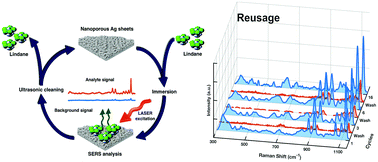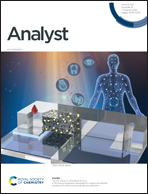Highly reusable nanoporous silver sheet for sensitive SERS detection of pesticides†
Abstract
Surface-enhanced Raman spectroscopy (SERS) enables pesticide detection at the point-of-need, but its practical application is limited by expensive and disposable SERS substrates. Here, we report a reusable nanoporous silver (NPAg) sheet for the SERS detection of organochlorine pesticides, aiming to maximize the cost-efficiency of substrate regeneration. The NPAg sheet is prepared by a reduction-induced decomposition method without chemical induced random aggregations. This SERS substrate is sensitive to various analytes regardless of their affinity to a metal surface such as rhodamine B, dichlorodiphenyl-trichloroethane (DDT), and lindane due to its large surface area and the coral rock-like morphology. The SERS signal of lindane, a typical organochlorine pesticide, is identified and quantified with a minimum detectable concentration of 3 × 10−7 M (87 ppb), which is below the maximum residue limits in various foods set by the regulators across the world. More importantly, after a few minutes of ultrasonic cleaning in water, the NPAg sheet can be reused at least 20 times with a reproducible SERS activity. Furthermore, the NPAg sheet remains stable in terms of its sensitivity and reusability after several months of bare strorage. Therefore, the NPAg sheet as a SERS substrate holds great promise for mass production and convenient applications in low-cost pesticide analysis.



 Please wait while we load your content...
Please wait while we load your content...